When evaluating digital intelligence platforms, marketing professionals often compare Semrush and Similarweb. This detailed analysis breaks down key features, pricing structures, and data coverage to help you make an informed decision for your specific needs.
Semrush has 3X more peer reviews than Similarweb.
| Semrush | Similarweb | |
| Capterra | 4.7 (2212 reviews) | 4.5 (98 reviews) |
| G2 | 4.5 (1998 reviews) | 4.5 (993 reviews) |
| TrustRadius | 8.5 (721 reviews) | 8.3 (207 reviews) |
| Trustpilot | 4.0 (657 reviews) | 4.0 (371 reviews) |
Disclosure: When you purchase through links on our website/article, we may earn an affiliate commission from Semrush.
To create an effective digital marketing strategy, it’s important we have access to accurate data regarding the user demographics and their possible areas of interest. Being able to look at what the competitors are doing, what channels they are investing in along with their revenue share from each can also be of great help to SMBs that are starting out on their digital journey.
Hence, both types of data have become equally important – data regarding your users and data regarding your competitors. And the tool of choice for gathering these is a marketing analytics platform.
Similarweb Alternative? Semrush vs Similarweb
The only way to find out if Semrush or Similarweb, is to pit them against one another. So, we ran some tests on Similarweb and Semrush, and assessed which one performed better. And, there are many reasons why Semrush is considered a better alternative to Similarweb.
7 Compelling Reasons to Choose Semrush over Similarweb
👉 Semrush has more accurate and reliable data.
👉 Semrush has a bigger, better keyword database (26B keywords v 5B).
👉 Semrush has unbeaten SEO features.
👉 Semrush has a larger backlink database with faster discovery (43T v 3.6T).
👉 Semrush puts all key market research tools together.
👉 Semrush includes all 190 countries and regions in all plans.
👉 Semrush has transparent (and lower) pricing.
What makes Semrush the best alternative to Similarweb (Feature by feature comparison)
| Features | Semrush | Similarweb |
| Google SERP database | ✅ | ❌ |
| Rank Tracking | ✅ | 💰additional cost |
| On-Page and Technical SEO | ✅ | 💰additional cost |
| Local SEO | 💰additional cost | ❌ |
| Core Web Vitals | ✅ | ❌ |
| Generative AI integrations | ✅ | ❌ |
| Daily and weekly data | ✅ | 💰additional cost |
| Geographic databases | worldwide data from 190 countries and regions included. May be combined for custom regions. | worldwide info only 💰country specific data available for added cost. One region at a time, no combining. |
| Historical data | From 2017 for .Trends. As far back as 2012 for other products. | 3 months for Starter plan 💰up to 3 years, at additional cost |
| Methodology & data collection | – clickstream, GDPR compliant – keyword & backlink databases – Google SERP analysis – partnerships | – clickstream – partnerships |
| Data threshold | no threshold | >5K monthly visits |
| Audience overlap | ✅ | ❌ |
| Industry analysis | ✅ | 💰additional cost |
| Traffic journey analysis | ✅ | ❌ |
| Traffic metrics for top 1000 pages for any website | ✅ | 💰additional cost |
| Quick insights cards | ✅ | ❌ |
| Bulk analysis | up to 100 domains at once | ❌ |
| Competitor activity tracking: new website pages, blog posts, social media posts | ✅ | ❌ |
| Competitor ad campaign tracking (Google ads) | ✅ | ✅ |
| Weekly email report summarizing: competitor activity (new pages/blog posts/social media posts/new ads) | ✅ | ❌ |
| Domains organic/paid positions | 26B keywords | 5B keywords |
| Keyword gap analysis | ✅ | ✅ |
| Advertising research, PLA | ✅ | ✅ |
| Keyword database | 26B | 5B |
| Question keywords | ✅ | ✅ |
| Click potential | ✅ | ✅ |
| On-demand metric update | ✅ | ❌ |
| Personalized keyword metrics and suggestions | ✅ | ❌ |
| Recommendations on text length, tone, readability, and plagiarism check | 💰additional cost | ❌ |
| Rephrase with AI | 💰additional cost | ❌ |
| Available social networks | Facebook, Twitter, Instagram, LinkedIn, Pinterest, Google My Business, YouTube, TikTok, Twitch | none |
| Cross platform posting & analytics, competitive analysis, mentions, monitoring and ads performance | 💰additional cost | 💰additional cost |
| Custom PDF reports | ✅ | 💰additional cost |
| Reporting templates | ✅ | ✅ |
| Scheduling | ✅ | ❌ |
| Google Looker Studio connector | 💰additional cost | 💰additional cost |
| Integrations | Google tools: Google Analytics, Google Search Console, Google Business Profile, Google Ads Social media: Facebook, Twitter, Instagram, LinkedIn, Pinterest, Google My Business, YouTube Text editors: WordPress, Google Docs, MS Office Other: Majestic, Trello, Zapier | Google Analytics |
| API data | – Traffic sources – Geo distribution – Subdomains/Subfolders – Top pages – Domain rankings – Audience insights (age, sex, household, income, interests, etc.) – Organic/paid results – Competitors – Top domains – Backlinks – Position tracking – Technical health – Keyword research | – Organic/paid results – Competitors – Top domains – Demographics |
| Support | Email and chat support, even without subscription or trial | Email and chat support for customers only |
See the facts and research that show Semrush is the better choice for competitor research, SEO, and digital marketing. Get more data, more features, and more growth opportunities with the Semrush .Trends bundle needs – impossible with Similarweb. Serious market research and online growth needs a no-limits tool. Here’s why marketers ❤ Semrush

1. Access Traffic Data From Over 190 Countries
Both Semrush and Similarweb have different collection methods. And this is reflected within their traffic analytics.
How Semrush collect data
With Semrush, you can access traffic data from 190 countries. They offer a breakdown based on devices used, global and regional locations, top pages and traffic sources. Semrush uses anonymously collected data from third-party sources and then processed by their AI algorithm. Thus, Semrush relies heavily on clickstream data and of course, its own keyword database of more than 20 billion.
Database and threshold
Essentially, it uses web crawlers to look through the data of localized search engines. Semrush has a reliable data provider as they collect data from different sources such as: clickstream , GDPR compliant, keyword & backlink databases, Google SERP analysis. This makes the Semrush database an extensive one, and its traffic overview spread across a larger area.
How Similarweb collect data
Similarweb works on an entirely different model altogether. While it also uses a web crawler, Similarweb also integrates its users onto its list of traffic sources. This means any using the Similarweb tool or plug-in offers their own browsing metrics and surfing patterns up for analysis by their AI. Along with this, it also relies on clickstream data.
Database and threshold
Despite Similarweb’s extensive reach, their major strongholds are in APAC, South America, North America, and Europe. If you require localized data about specific regions, you will have to invest in accessing a local server separately. This is on top of the regular subscription fee!
Similarweb puts a threshold of a minimum of 5000 monthly visits for the user data and demographics to be displayed. Hence, SMBs might find it harder, to begin with.
Semrush vs Similarweb tally
Based on Semush’s extensive database and the intuitive UI that allows an extensive breakdown of every single analytics, we’re giving this one to Semrush.
2. Know your audience better
To plan a strategy, it’s important we know what your audience is looking at. This not only includes the most-searched topics, but also the competitor pages that are being browsed simultaneously. So, here’s how they both perform.
Semrush
Overlapping Audience
Semrush allows you to compare the overall audience of 5 different sites at once. The result is displayed in the form of a Venn diagram where you can easily see the common audience at a glance.

Audience Demographics
Semrush provides audience demographics on a country-wide basis, based on their data collection from organic domains. You can check out the major demographics and social media referrals.
Semrush is very clear about the strategy they use for this. Their Market Explorer AI sifts through backlinks, organic keywords, SERP positions and more to provide an overview. However, to get a more detailed analysis you will have to get an extra pack.

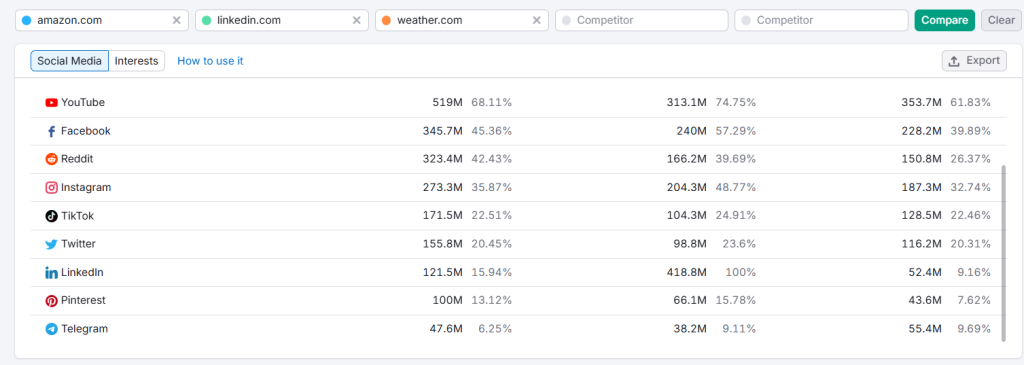

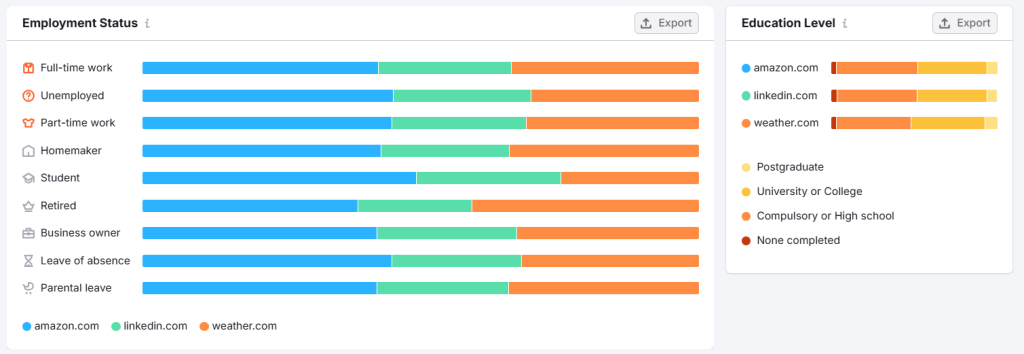
Audience Interests
Semrush lists the top sites for every domain you are comparing, along with the unique and shared audience they have. For each site, once you click on it, Semrush offers the top 4 categories of the site.


Similarweb
Overlapping Audience
Similarweb also allows you to compare up to 5 sites at once. But, their comparison data for the same is based on the industry categories, devices used, and overall engagement. It does not offer any form of segregation between the users of different sites. It merely lets you compare the traffic share, page visit duration, engagement etc. across the 5 domains.


Audience Demographics
In terms of demographics, Similarweb allows you to access it in two forms. Either, you can look up the demographics of listed sites, or you can look up the demographics associated with a specific industry. For both, they offer the traffic share, age, gender and location details.
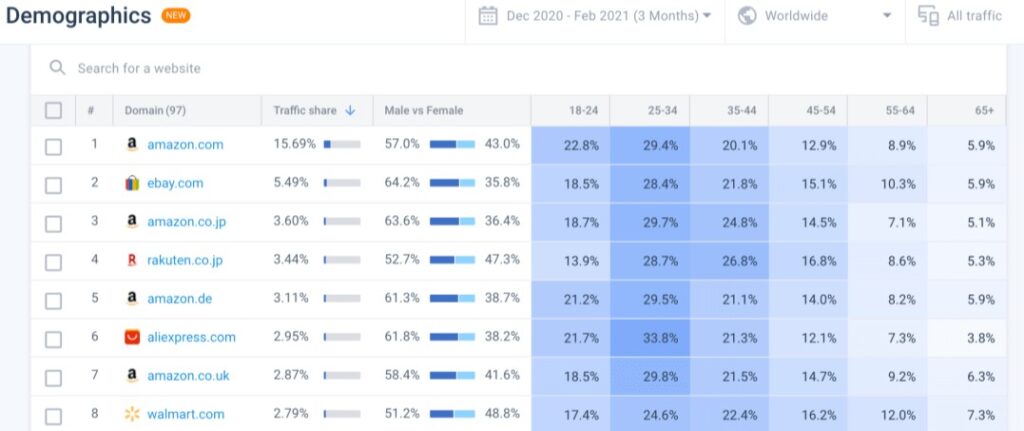
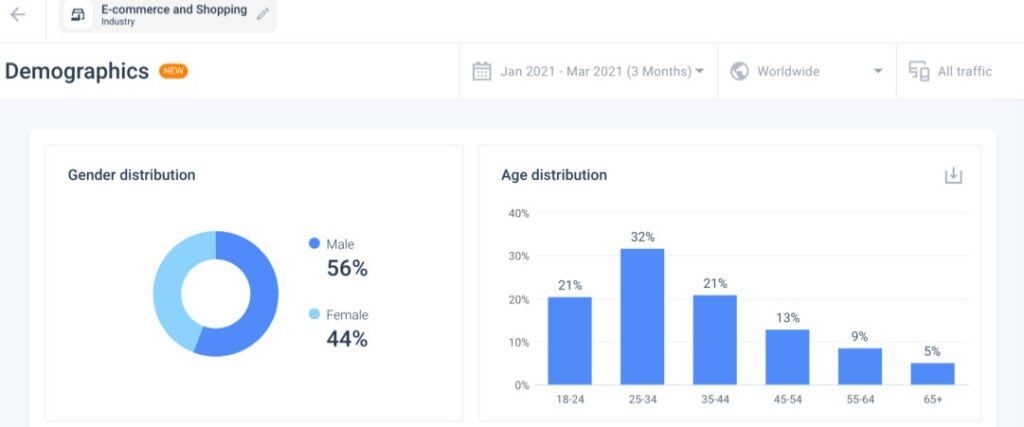
Audience Interests
You can check the top-accessed topics for any selected website. Here, we see the top interests of the users of Amazon India. Similarweb displays both the audience interests (in industry terms) as well as most-searched topics within these.

Common search terms appear in a grid as shown where the size of the word corresponds to its popularity. While this is an interesting visual, it is not exactly something you can work further with.

For comparison between the audience, you can access a sheet like this. But there is no way to segregate the users using filters.
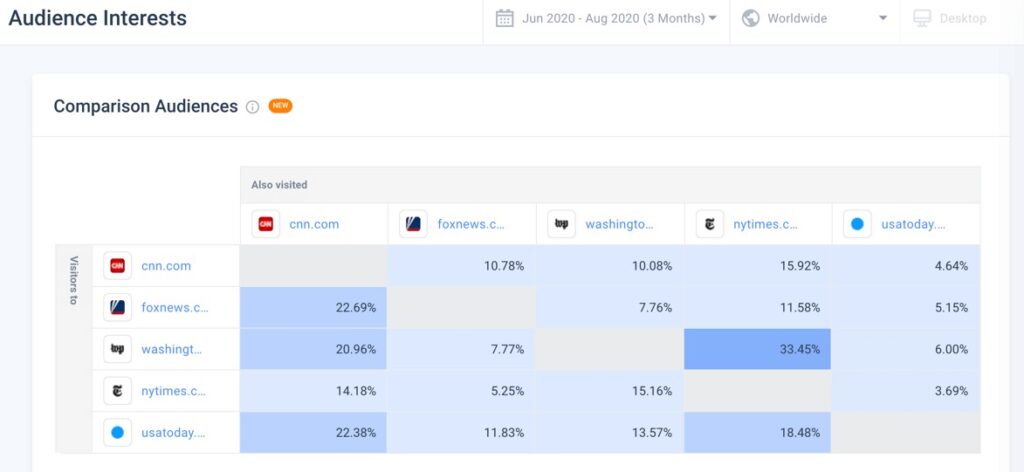
Semrush vs Similarweb Tally
Semrush offers an in-depth comparison along with interesting visuals and great filtering capacities. Not only this but their device engagement chart is included in the subscription whereas for Similarweb it is an add-on.
3. How are your competitors earning?
Semrush
Semrush comes with Market Explorer that allows you to see all types of data pertaining to your competitor. This includes their market overview, their growth in this year’s quadrant, their growth divided by sources, and overall geo-distribution. Moreover, Semrush allows you to perform bulk analysis of up to 200 websites at once and export the results as a CSV file.
Market share
The overview section offers a clear view of the amount of market share and traffic a domain channelizes.

A further breakdown reveals the total visitors across the year along with their referral strategy. This allows you to see at a glance which strategy is working best for whom. We can see here that Amazon derives the highest total traffic. And when we compare it with its referral, we see a high percentage of it comes from paid advertising.

If you’re now looking to compare how you are performing, you can check out the traffic trends section. This is essentially an overview of your own growth sources. Based on this, you can capitalize further on them or focus on the ones less explored.
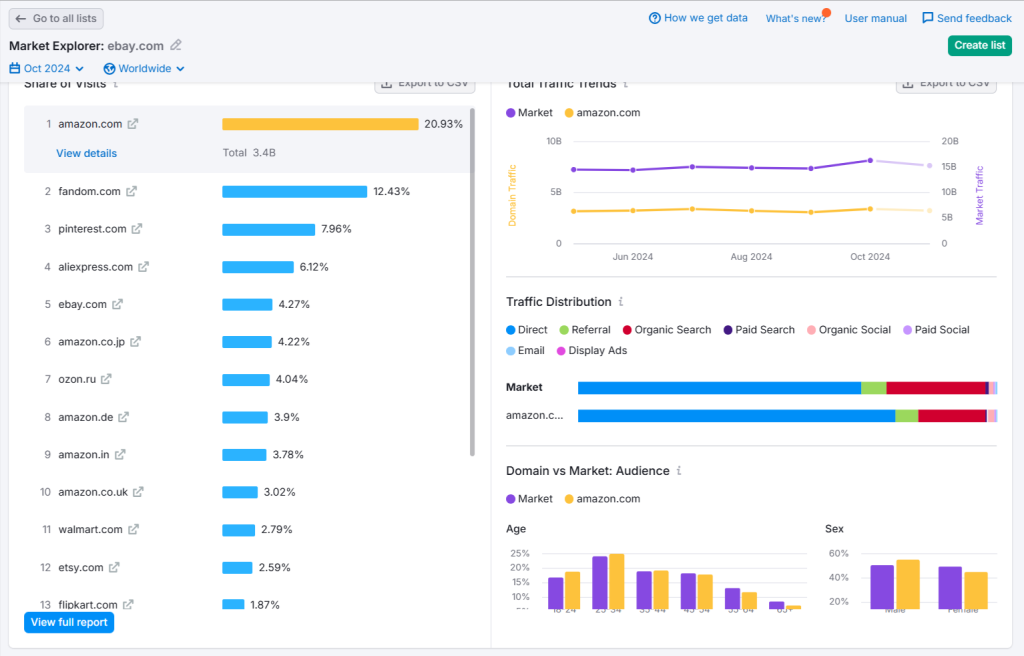

Traffic generation strategy
However, what most users will find interesting is the Benchmarking feature for Traffic Generation Strategies. This is available under Semrush.Trends. Semrush allows you to identify your top 5 competitors based on organic searches and their traffic generation strategies.

In fact, Semrush goes one step ahead of its contemporaries to show the market share from each channel, along with the referral received. This type of detailed breakdown is rarely seen in other tools. Semrush also automatically highlights the channels that are performing well.
Market share By channel
As mentioned above, here we see a further breakdown of the chart. If you’re looking for numbers, Semrush has it right here. This allows you to see from which channel your competitors are receiving their maximum traffic and whether it is paid or organic.
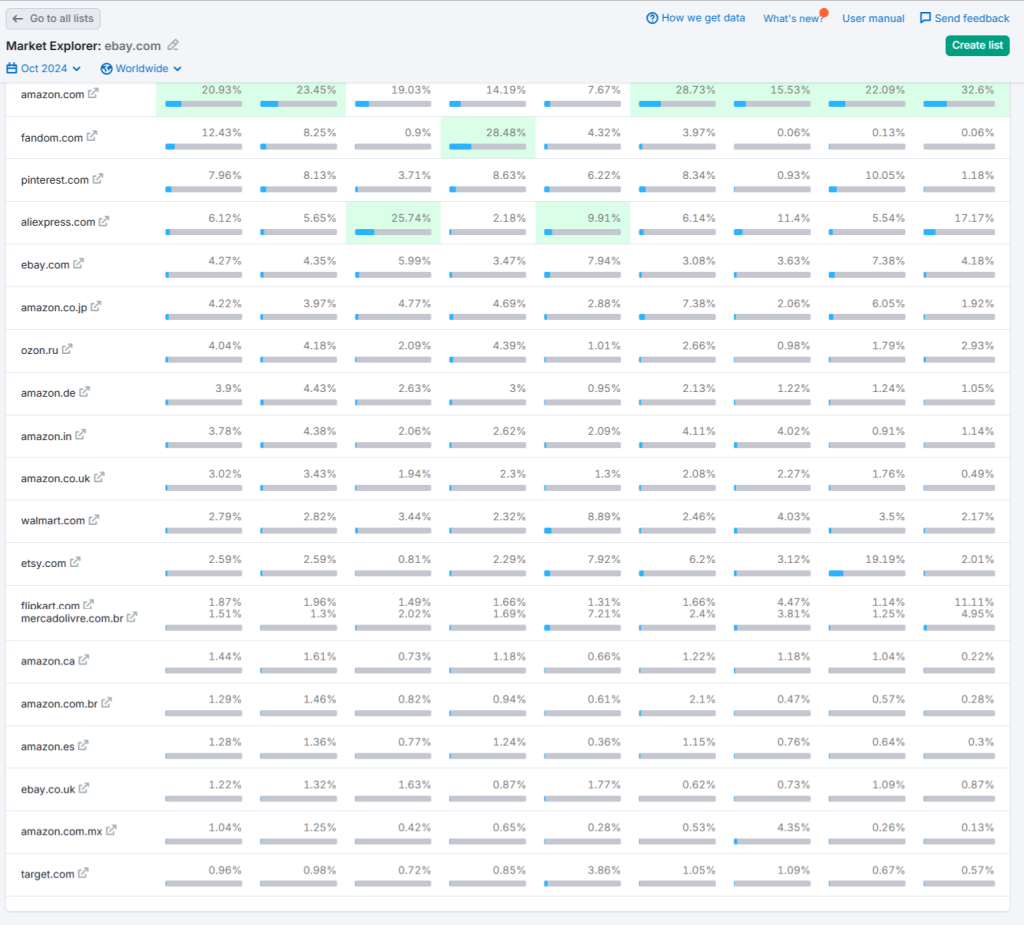
Competitive market positioning map
With all these numbers, it is inevitable that you will want to know exactly where they stand. Under the Organic Research section, you can find two types of such maps.
The Competitive Positioning Map is a comparison between the keyword success and total domain traffic achieved as a result.

The Growth Quadrant on the other hand helps you to visualize the landscape. It places your business within those of its arena by dividing them as Leaders, Established Players, Game Changers and Niche Players. Every company has a vision, and hence the Quadrant features a Growth Path that you can work upon achieving.

Similarweb
There is much you can learn from competitors and Similarweb does offer certain features for it. However, Similarweb does not offer a separate screen for analyzing only organic traffic.
Market share
You can compare up to 5 domains and see their projected market share along with the channels used.
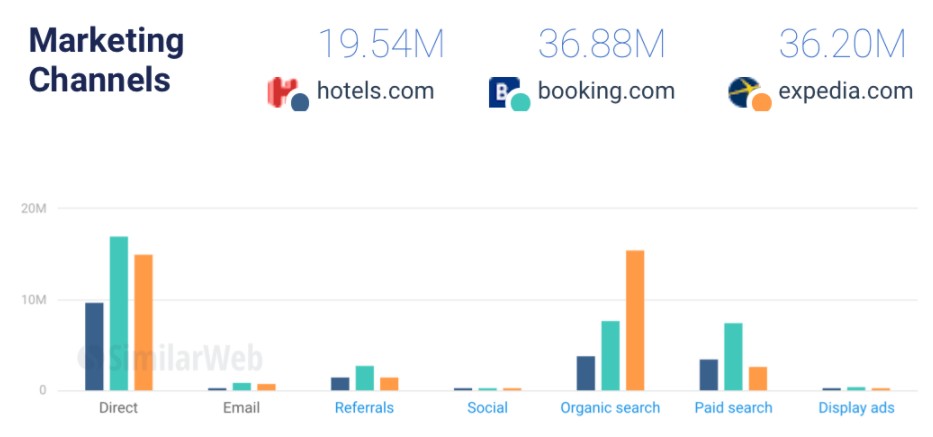
You can also compare the overall traffic and engagement as shown below:
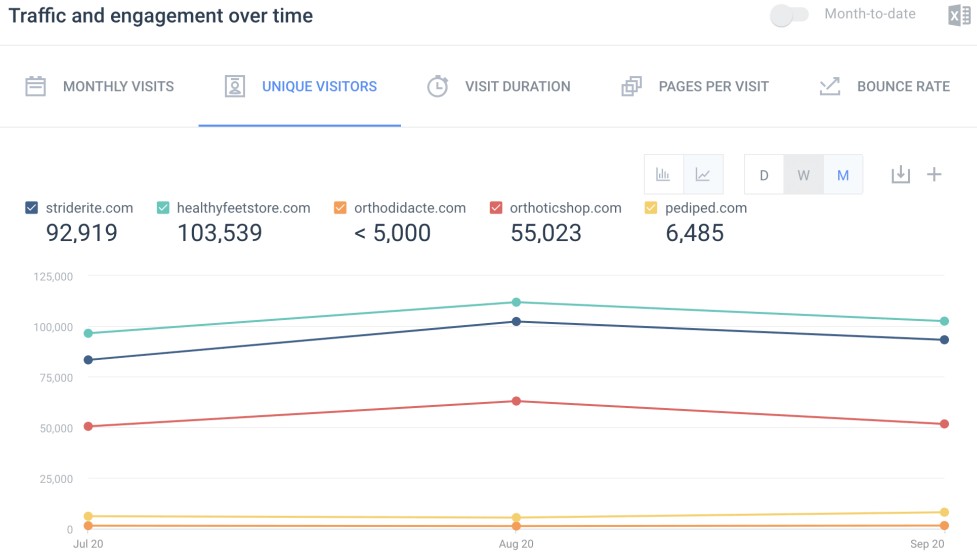
The comparisons are made based on the keywords and consequent traffic each generates. Once can access charts that break down the traffic as paid vs unpaid, channel-wise or source wise.

You can look at the overall traffic and revenue garnered from both organic and paid keywords, and filter it based on search engine or social media typology. It also offers information regarding the CPC for each performing keyword. As far as keywords go, Similarweb allows you to break it down based on the geo-location, branded/ non-branded, difficulty level and more.
Despite this, it is clear that Similarweb does not go as in-depth as Semrush does when it comes to collecting competitor information.
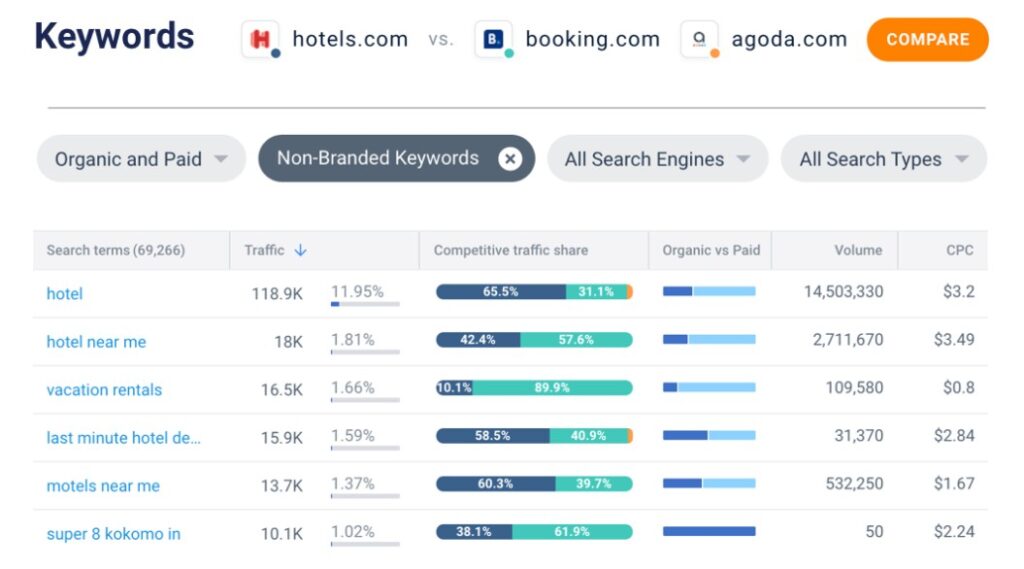
Traffic generation strategy
One interesting feature Similarweb does offer is the Ad Network. This allows you to see which streams your competitors have targeted for sponsored ads and what is their overall revenue distribution from each. This could be a great insight regarding the plausible performance of your domain as well. Semrush offers this with their AdClarity App, available starting at $169/mo.

Market share by channel
This feature is similar to that offered by Semrush. We’re looking at a channel-wise breakdown for each competitor. Similarweb offers an extremely aesthetic view of the same in the form of a graph, along with an option to download detailed data in the form of an Excel or CSV file. Here, Similarweb goes one step ahead and offers data regarding the average page visit and bounce rate of each.
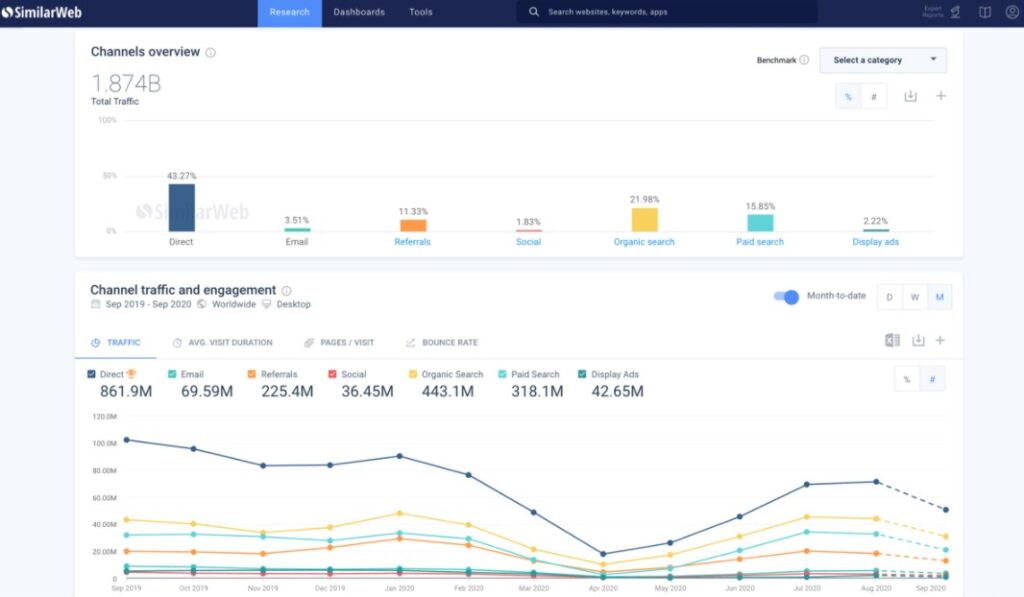
Competitive market positioning map
While you can compare and see many chart-wise visuals based on traffic, engagement, time spent, etc. Similarweb does not allow any AI-generated market positioning map.
Semrush vs Similarweb Tally
Both Semrush and Similarweb have taken different approaches when it comes to analyzing competitors. And both have quite good analytic tools for the same. Hence, both Semrush and Similarweb perform well in this space.

4. Breakdown of competitive traffic analytics
Referrals are important because they help us realize who is directing traffic towards us. The data could well help advertising agencies pick up the right avenues to spend their capital on. However, it is not enough to just check how users land on your page. You must know: Is your page their final destination as well?
Semrush
Traffic Analytics
Semrush offers a much better and intuitive UI that allows you to gauge information at a single glance. Traffic analytics stats are broken down by unique visitors, pages per visit and average duration.

But most importantly, Semrush tells you if this is better than your previous performance or not by a small indicator beside it!
With Semrush, you can also access the top-visited pages along with the sub-folders and sub-domains preferred.
You can also access the traffic distribution based on the locations of the users. Semrush offers both desktop and mobile browsing data. You can access a more detailed report that offers indicators based on past performance.
Semrush has launched a new metric designed to help SEO professionals estimate traffic from target keywords with precision. It provides insights into the potential traffic your website could get for any keyword, tailored to your domain.
This AI-powered tool is designed specifically for your website. Unlike general forecasting tools, Semrush uses domain-specific data to provide precise estimates. It evaluates keywords based on your domain’s highest potential ranking, considering your competition and topical authority. This focused method delivers accurate and relevant predictions tailored to your site.
Traffic Journey
Semrush offers a full-fledged traffic journey that includes the referral site as well as the destination site. It also highlights which of these are paid and organic in the same chart along with indicators for its performance.
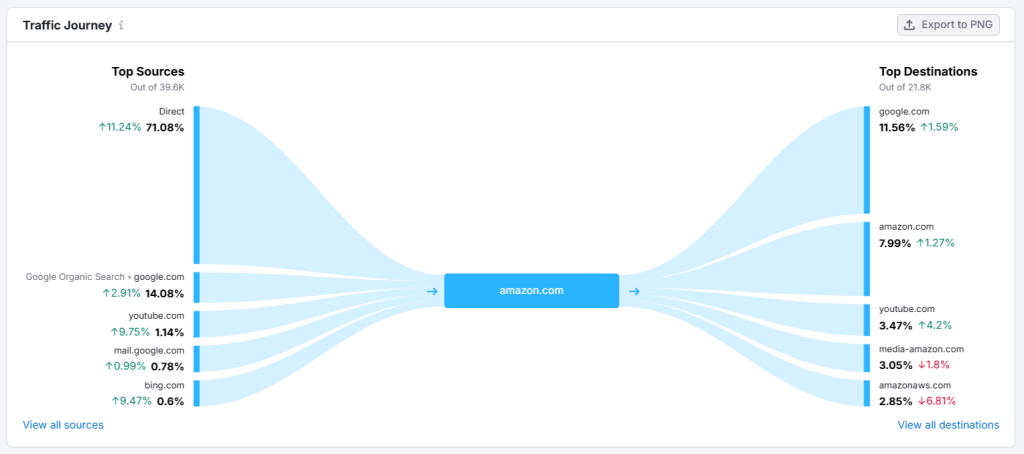
The traffic journey details are broken down by referrals, search engines and social networks. All of this data can be exported in the form of a CSV file. The indicators are based on monthly performance which is revealed if one hovers over it.
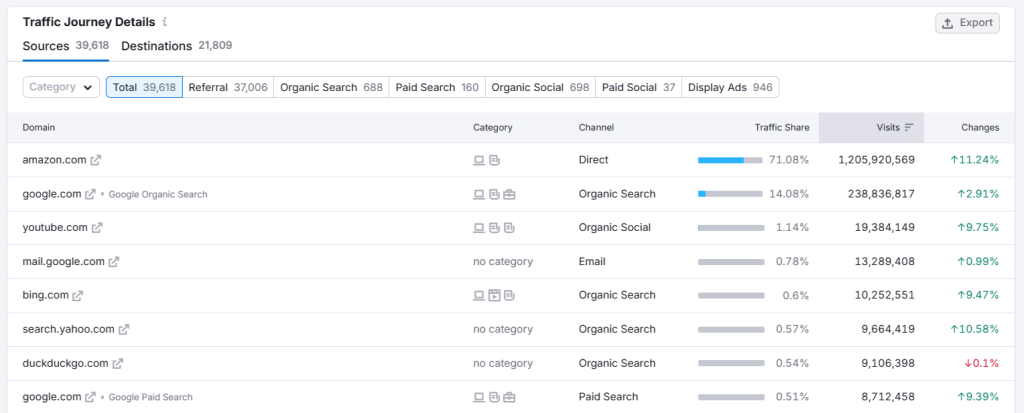
Using the earlier comparison tab, you can compare the traffic journey for up to 5 different sites to see which SE or social network performs best for each.
Similarweb
Traffic Analytics
The traffic overview offered by Simialrweb is consistent with what Semrush offers. It looks at global rank, users and visits, time spent, devices used, and related mobile apps.
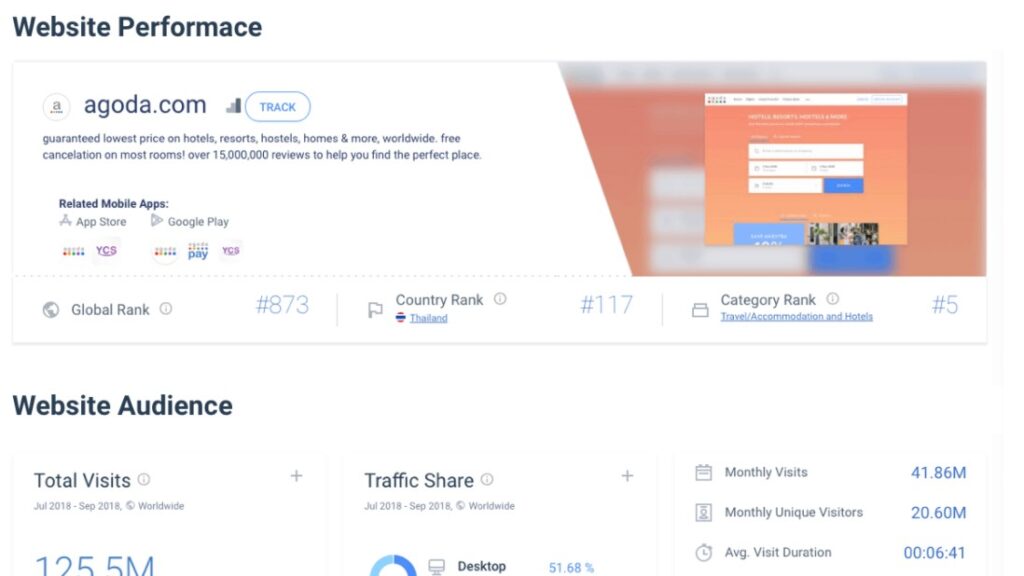
Similarweb allows you to see the most popular pages (not just domains) for their website. It also allows insights as to the best performing one based on CPC rates. However, there is no breakdown for sub-topics and sub-folders.
Like Semrush, Similarweb also offers traffic share based on the countries and user location along with performance indicators. But it only offers this for desktop data. For mobile users, you will have to buy addon.
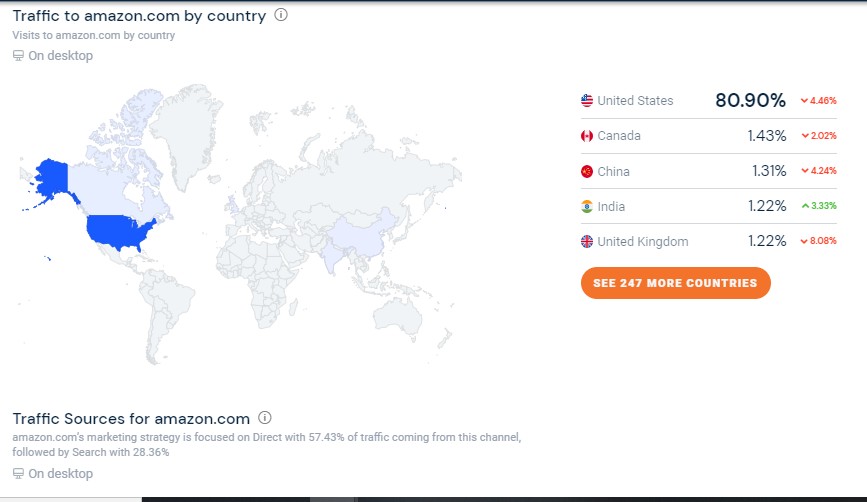
Similarweb also offers a traffic breakdown based on the sources as shown below. However, it only provides a further breakdown for Social channels only. You cannot access the breakdown for channels like search engines and mailing sites.

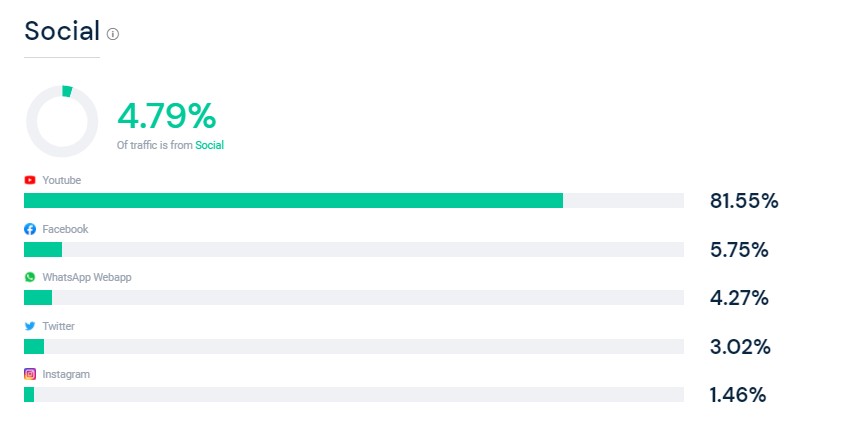
Tally
Based on the device and referral breakdown Semrush provides, the vote here unanimously goes to them. It is interesting to note that both Semrush and Similarweb offer a yearly comparison. The latter certainly makes more sense as certain months are better performers and hence can only be compared to themselves. However, charging extra for mobile user data and geographical regions is again something only Similarweb is doing.
5. Top-Notch SEO Tool
Both tools offer exemplary features and comprehensive metrics that allow one to identify the best keywords based on industry and traffic data. While finding the right keywords to monetize is important, so is finding the gaps.
Semrush
Keyword Research
To help you find the best organic keywords, Semrush offers the Keyword Overview feature. Here, I performed a search on “apple iphone 7”.

The breakdown includes the global volume, CPC, monthly search rates, along with keyword variations and questions.

However, if you’re looking for more variations with the keyword, then you can use the next feature that Semrush provides.
Keyword Magic Tool
The Keyword Magic Tool expands upon a keyword variation based on numbers and volume. It offers data regarding the keyword density, a short graph to assess its growth and the CPC. Here, we can see at a glance that the fourth option is in an upwards trend.
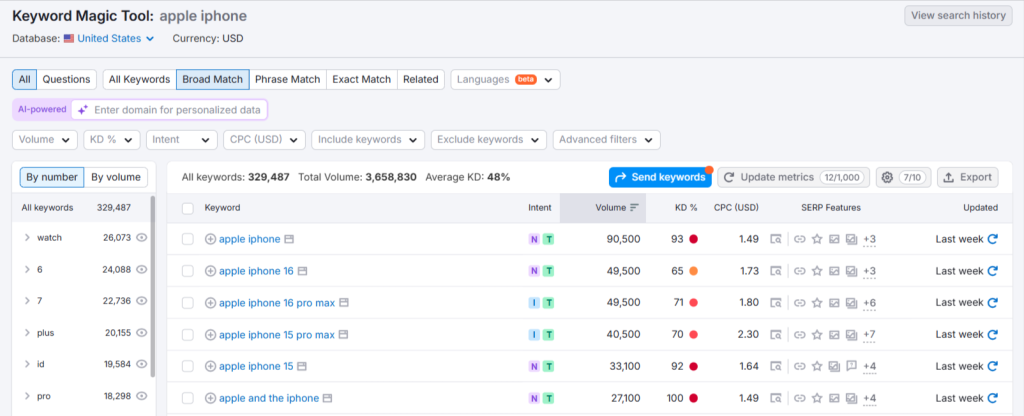
If you click on a keyword, you can get more details regarding questions, their general trend and other related keywords or parent terms.

These can be filtered using their advanced filter options to include words, volume ranges, CPC or difficulty level. When compared to a competitor (in this case Flipkart), it allows you to see what are the common ones for both, and which are the ones either are missing out on.
Semrush divided the keywords into those that are shared, missing, untapped, strong, weak, and unique. For each segment, you can just click on “To Keyword Manager” to create a list containing them all for later analysis.

You can also look at these depending on the device. Furthermore, they offer breakdown data for organic searches, including recent position changes, SERP features and competitive positioning based on the keywords. In this section, Semrush features exclusively on organic keywords only.
Keyword Gap Analysis
The Keyword Gap focuses on both organic and paid keywords as this pits you against your competitor. However, you can choose to filter your results on only organic, only paid or only PLAs. This feature compares the URLs of your and your competitor sites and finds the best opportunities and missing links for each.

PLA Research
Semrush’s PLA tool allows you to access your competitor’s historical data regarding their product listings, their best sellers and their overall PLA keyword performances. All users get 10 free results per report. If you want more, you need to upgrade to Semrush’s Business Plan. You can see historical data as far back as 4 years.

Similarweb
Keyword Research
Similarweb allows you to check up individual keywords or extract the top-performing ones for a particular site. In the Analyze Keywords section, you can type out phrases and see their performance over time. This includes their traffic share, CPC and search volume. Along with this, related words are listed below. Here, a search has been performed for ‘website builder’. Similarweb’s keyword search does not only focus on top organic keywords, but it shows the best competitors of the keywords – both paid and organic.
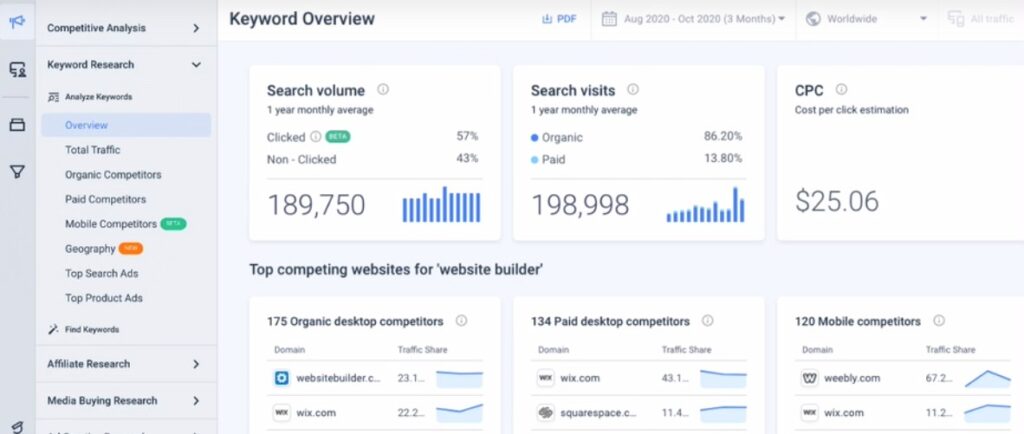
It also offers the traffic distribution of the selected keyword across the top-performing sites.
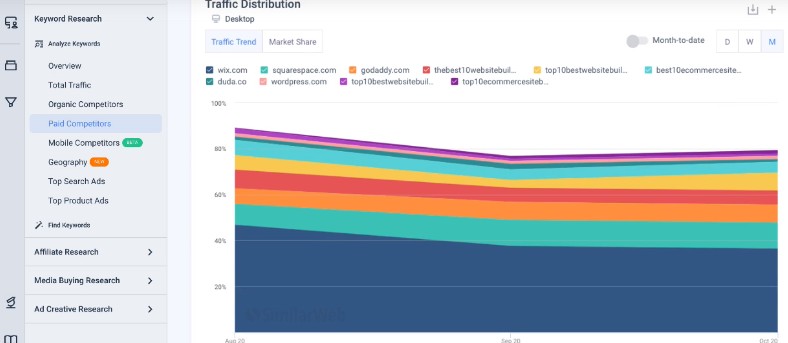
However, more importantly, it allows you to see the performance of the keyword in the form of a small graph on a country-to-country basis along with its paid vs. organic performance bar.

Keyword Generator Tool
There is no Organic Search feature, but you can use the Keyword Generator to find the trending ones suited for your business.
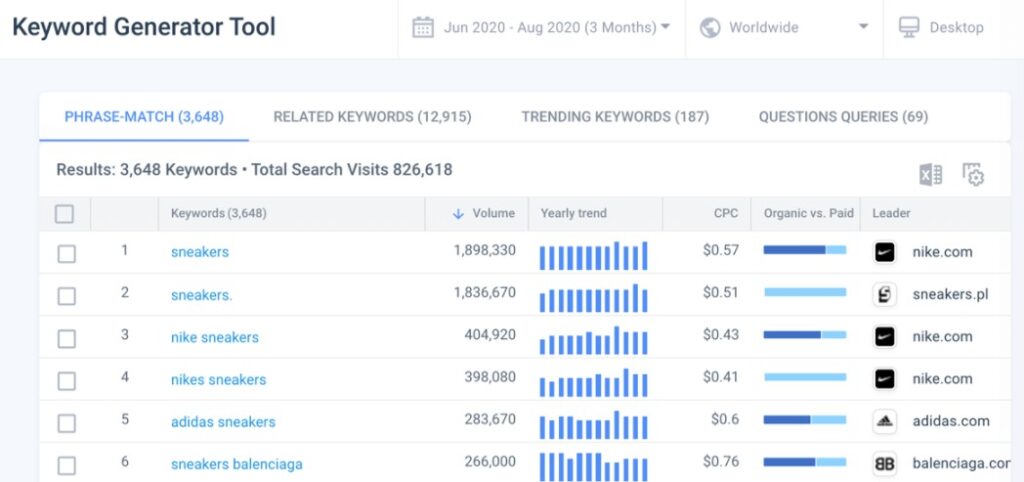
After this, you can access details for each which opens in a new window. This is a much longer process and involves multiple clicks as compared to the Semrush window which displays it all at once or utilizes pop-up windows for the same.
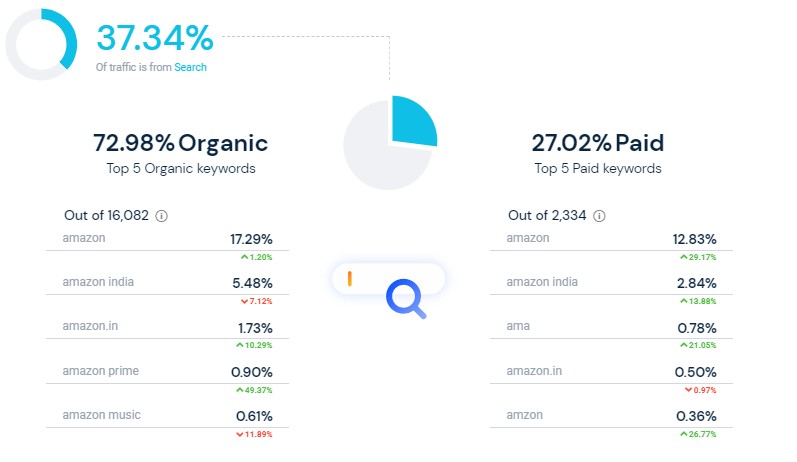
Similar to Semrush, they allow filtering based on CPC, volume ranges and other factors. However, their filters are easier to implement than that of Semrush since they are displayed in the form of buttons as opposed to being drop-down lists.

What Similarweb does differently is it allows filtering based on the industry. Hence, once you have identified the top audience interests and industries, you can target the top keywords for each.
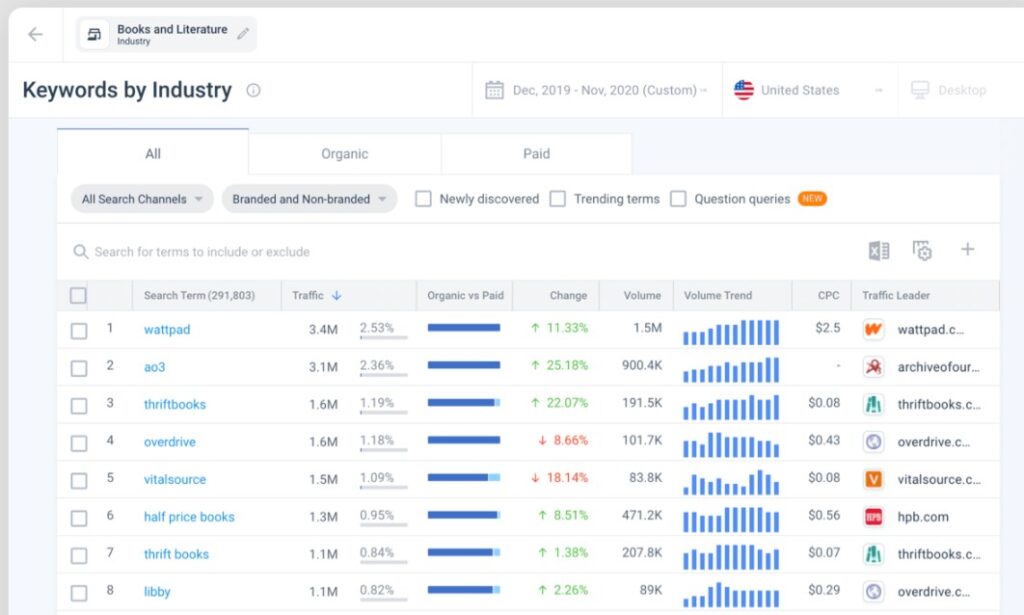
Along with this, you can compare multiple sites to see the top common keywords for all – both paid and unpaid along with their traffic share and CPC.
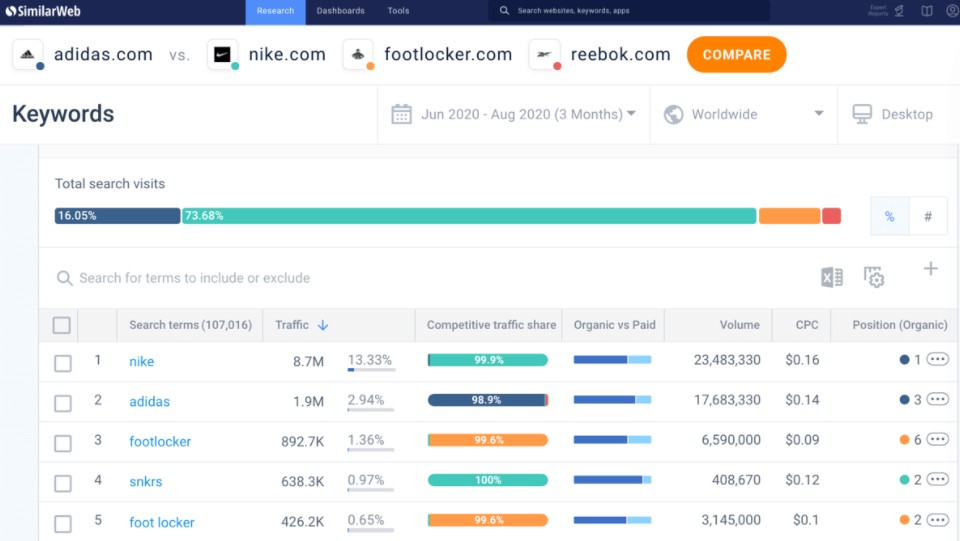
Keyword Gap Analysis
Similarweb offers a robust keyword gap analysis. Here, it offers a similar Venn diagram which shows both the organic and paid keyword overlap. It also generates a Keyword List along with a traffic estimate and volume share data.
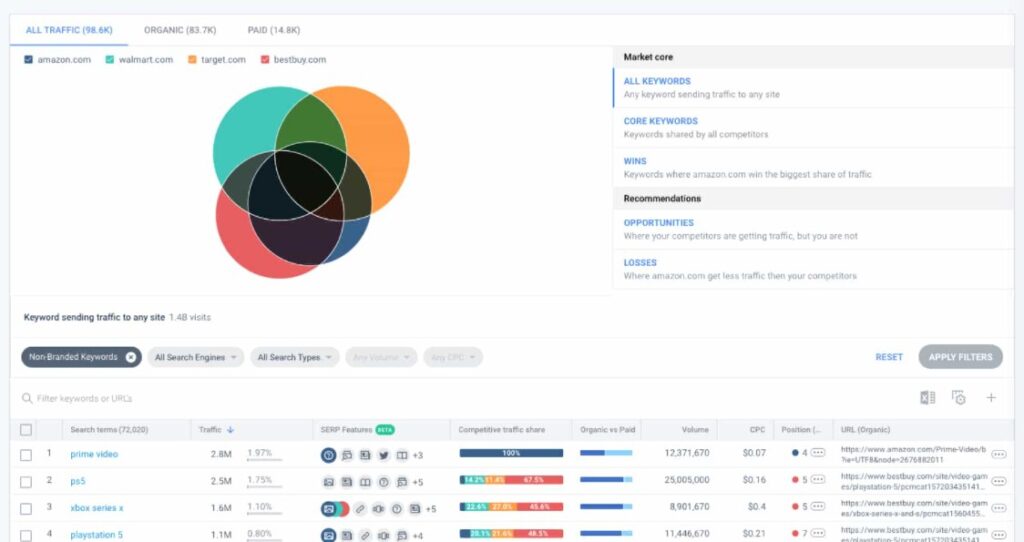
Seasonal Keywords
Seasonal Trend is a new feature by Similarweb. While looking at the keyword overview, you can simply click on the button at the top to see the months when certain keywords perform the best across multiple sites.
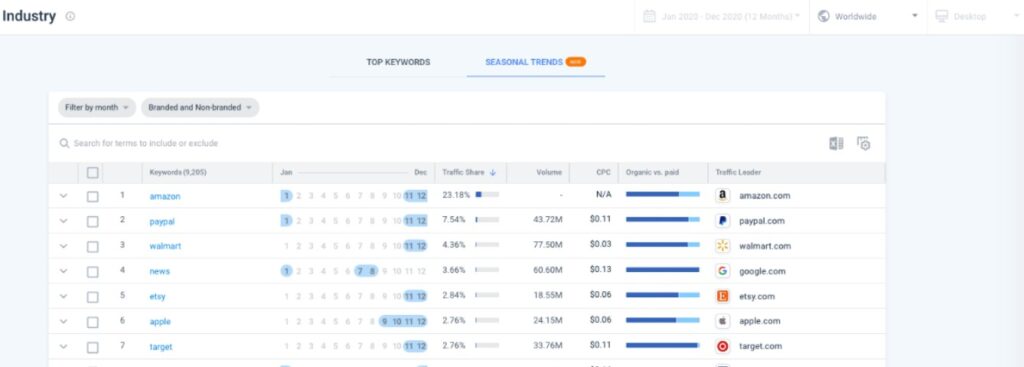
PLA Research
Known as the Top Product Ads section, this allows you to see the product lists for various keyword variations. Details include the domains, landing pages, keywords and SERP position. SImilarweb’s historical listing only goes as far back as 3 years.
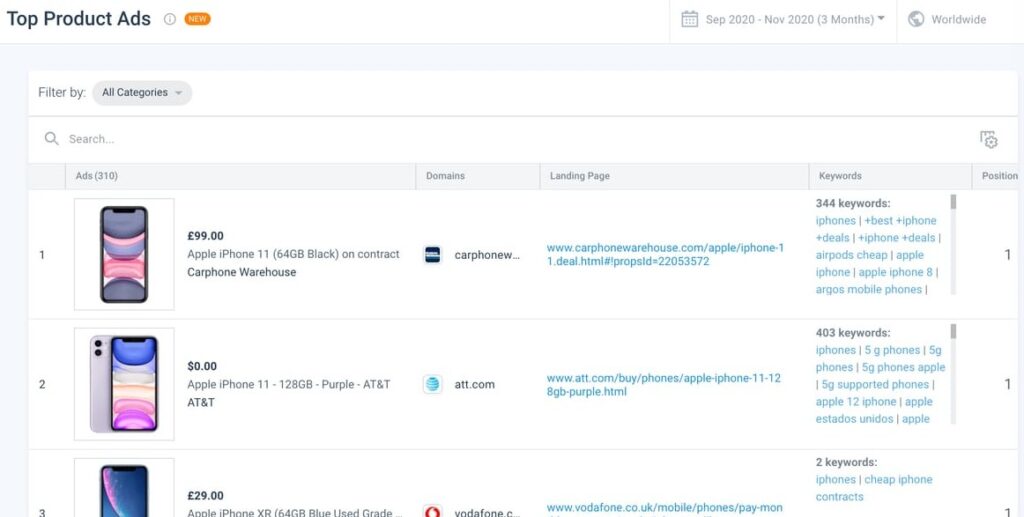
Semrush vs Similarweb Tally
Semrush not only offers a better breakdown but does so in fewer clicks. Similarweb uses too many different screens and the overall process is much lengthier. However, it offers a Seasonal Trends breakdown, which could be quite useful for some industries. Overall, both have different approaches and we will be awarding one to each.
6. An All-in-one Platform For All Digital Marketing Needs
While plug-ins will always be something to rely on, they slow down a system. And everyone is looking for a tool that can accomplish more within itself.
Semrush
SEO Tools
Semrush does not offer only traffic analytics. It allows you to manage lists, track your position, schedule social media posts, carry out site audits, perform competitor analysis, find backlink and keyword gaps, monitor your brand, find the right advertisers and more.
It is a complete all-in-one tool that has everything a marketing team could possibly need to aid their efforts. It offers sections for finding the right content, conducting advertising research, generating leads and more. While some of these are add-ons, it is nice to have them all within a single workspace.
We will take a brief look at what the SEO tool section encompasses.
Site Audit
This essentially performs a check on the overall search engine friendliness of your site. Semrush’s strength is that you do not need to perform this separately. You can simply add a particular site as a project and Semrush will continuously crawl it and keep updating the reports in this section. This is what a detailed report looks like.
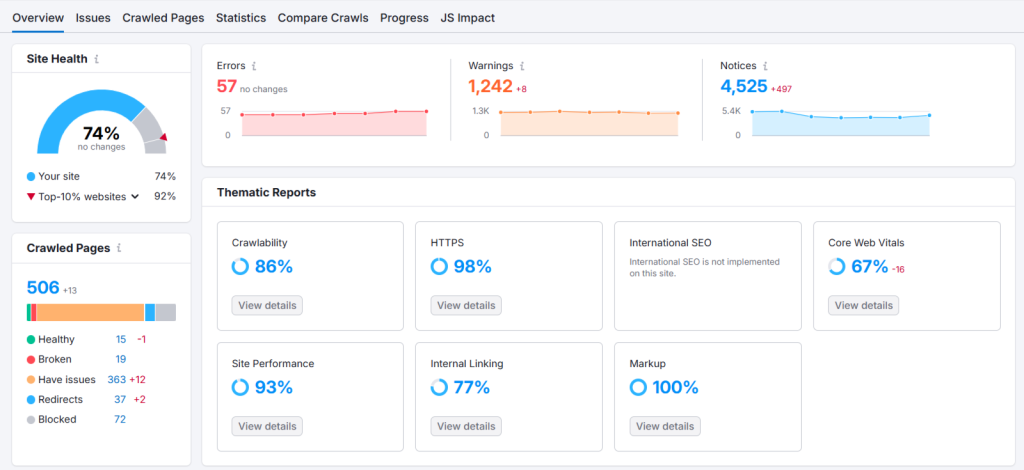
Along with this, you can zoom in on the exact problems like broken links, 404 errors, hreflang issues, slow loading speed, etc.
Position Tracking
This feature looks at the target keywords and tracks their health. Hence, if any keyword drops down in performance, or suffers from cannibalizations, you can expect it to show up here. Position Tracking is a one-screen view to see if your content is up-to-the-mark or not.
The page also returns the keywords which have the best impact on your site. For each keyword, Semrush offers a detailed visibility report and traffic.
Similarweb
Similarweb is good at what it does, which is – Analysis. It allows you to find all types of metrics regarding keywords, industry categories, user demographics, web traffic and more. You can use it to access global and regional data along with information regarding your competitor’s traffic and revenue share. With their keyword tool, you can even generate and identify the top ones for your domain. However, there are no other SEO tools, marketing tools or social media tracking tools integrated within it.
Semrush vs Similarweb Tally
It is clear that Semrush offers way more features. With over 50 different tools within a single workspace, you can forgo the hassle of adding multiple plugins and syncing email lists and keyword data across platforms.
7. Social Media Management
Social Media is an indispensable part of digital marketing. However, only Semrush offers a tab for managing lists, scheduling and ads.
Semrush
Semrush offers a Social Media Toolkit that has all the features that a stand-alone direct publishing and scheduling platform has. It can sift through user demographics and their active times to find the best posting times. It can schedule posts on social media in bulk. You can even use it to edit and post images to Instagram and Pinterest directly from the Semrush dashboard itself!
The features offered differ based on the social network chosen. As of now, Semrush can support 7 top social platforms. In fact, Semrush allows you to customize and post the same content to multiple platforms at once from the Semrush dashboard itself.
Similarweb
While you can use Similarweb data to create effective social media strategies, it does not offer any specific social media toolkit.
Semrush vs Similarweb Tally
The social media toolkit is specific to Semrush only. Hence, we have a clear winner in this section.
8. A Platform For Content Marketing
In the digital world, content is certainly king. For a company’s survival, it is essential to stay up-to-date with the trends while preparing exclusive content in advance.
Semrush
Semrush offers an entire platform for content marketing. So let’s take a look at the features this section offers.
Topic Research Tool
Semrush’s Content Marketing Platform offers a simple and straightforward journey for content writers.
All you need to do is enter the topic into the search bar along with the country specification. Semrush then returns various topic cards. The topic cards are generated based on the current interest in these topics and their search volume. For each topic card, Semrush offers up to 3 topic options.

However, if you are looking to create your own topic, you can check out the mind map section. This offers an overview of the common keywords from each along with some headline and questions so that you can create your own header.
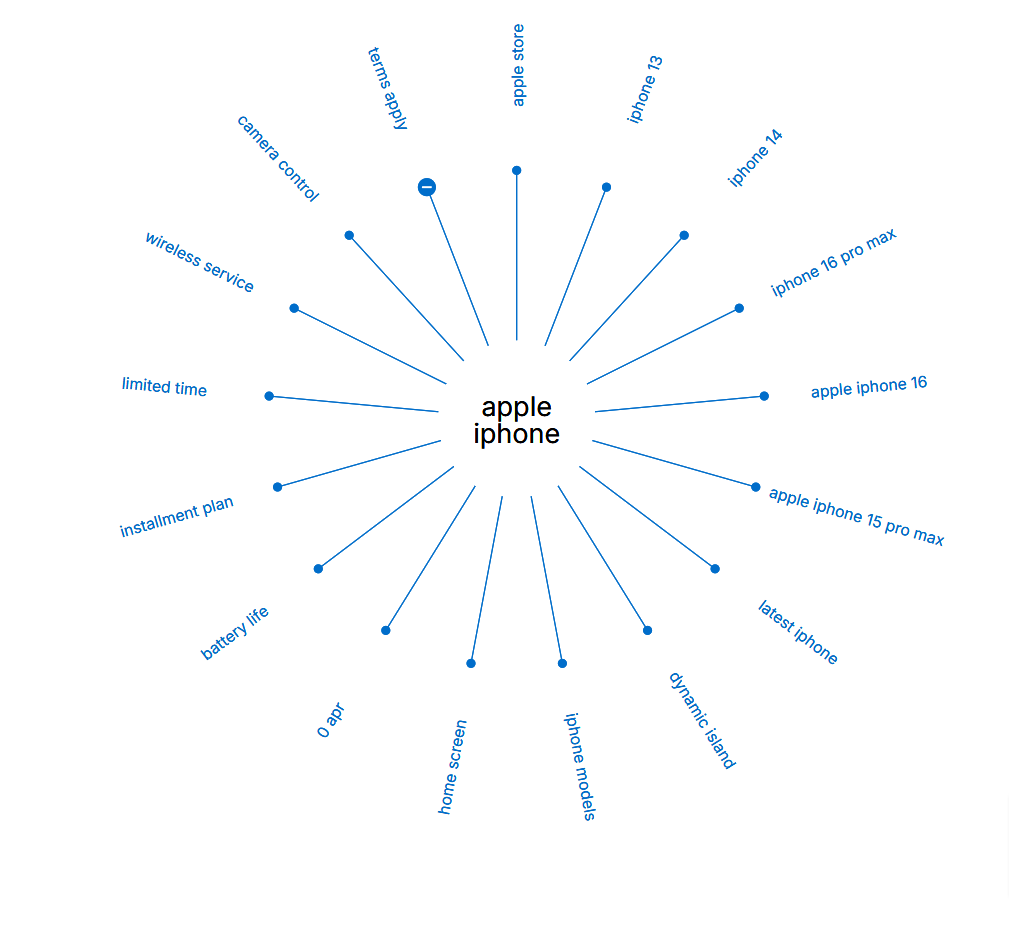
SEO Content Template
This is similar to a structure suggestion. Based on the keywords entered, Semrush offers possible topic recommendations, topic length, keywords, headers, FAQs and more. Semrush groups keywords based on their semantics so you can easily find groups of similar data without sifting through hundreds of them. There is even a separate section that allows you to see how your competitors have used the same keywords. Essentially, this is everything you need to craft a perfect topic.
After this, you can simply go to the writing assistant, which works similar to a content management space and start writing while setting goals. You can integrate it with Google Docs or your WordPress writing space too!
You can use AI and Semrush’s SEO data to produce high-ranking content up to 12 times faster.
ContentShake AI is an intelligent writing tool that merges AI capabilities with competitor insights. It supports you through the entire process, from idea generation to publishing, creating SEO-friendly articles and optimizing them for traffic and engagement. User-friendly and efficient, it requires no advanced skills or additional research.

Similarweb
Again, Similarweb does not offer any exclusive features for content marketing.
Semrush vs Similarweb Tally
Since Similarweb does not offer any such features, we have to award this point to Semrush. Not only does it provide a detailed result on any topic, but generates a great structure as well. The constant site audits will also ensure that the topics get updated.
9. Collaborating With Others?
A single report is often shared and accounted for by multiple people belonging to different departments. Hence, good collaboration and sharing features are a must for any analytics platform.
Semrush
For every data offered, Semrush allows you to download the report in the form of a CSV, Excel or PDF file. For images, PNG options are available. Furthermore, you can choose to work with Semrush’s existing templates or build you by themselves. You can save custom colors and change the report’s theme to match that of your brand.
Similarweb
Similarweb allows downloading of reports in the form of PDFs for engagement, traffic and keywords. However, other things such as traffic share details, ad network details etc., are not available for download. Reports cannot be customized.
Semrush vs Similarweb Tally
Semrush offers a more flexible system for sharing and downloading reports.
10. API And Integrations
Semrush
As of now, Semrush allows integrations with 10 Google products including Google Analytics, Google Search Console, Google Ads, Google Looker Studio and more. Apart from this, they allow social media integration with Facebook, Twitter, Pinterest, LinkedIn, Instagram and YouTube. Other integrations include Majestic, Zapier, WordPress and Trello.
The API key allows access to data regarding traffic, backlinks, keywords, competitors, position tracking and technical health.
Similarweb
Similarweb allows integration with Google Analytics as it is primarily an analysing software. Similarweb integrations on the other hand are available for other platforms like SalesForce, Looker, Snowfflake, etc.
The API key provides access to information regarding user demographics, traffic, competitors, and domains.
Semrush vs Similarweb Tally
Semrush offers more integrations as expected due to the larger ground it covers in terms of social media and content marketing. Both offer integrations for the grounds they work on, hence I am awarding a point to each.
11. Competitive Pricing
After all is said and done, how much lighter will our purses be in a bid to get these tools? Let’s break it down.
Semrush
One thing Semrush is clear on is their pricing. They offer three stacks – the Pro, Guru and Business level plans. Each is defined for businesses within a certain range and you can easily upgrade anytime once their work flourishes. Semrush .Trends is an add on though.
Similarweb
Similarweb, on the other hand, offers customized pricing based on your needs. This means, depending on the features you want to access, you’ll be assigned to a salesperson.
Having said that, the prices are not as transparent and the final price would be much higher than on Semrush. They do offer a free plan, however, this offers extremely basic insights and also does not allow the exporting or downloading of any report which makes it difficult to use the keywords lists or CSV files anywhere else. You cannot access the keyword tool with the free version. This makes the enterprise version a necessity for agencies of any scale.
Semrush vs Similarweb Tally
There is much clarity and transparency regarding the way Semrush charges its rates. Their free trial version also allows a clear understanding of how each feature will work, along with details on which feature will be an add-on. For add-ons, Semrush offers a trial. The Similarweb free version on the other hand limits the use of various features.
Semrush vs Similarweb: The verdict
While both platforms are used by major brands across the world, based on our test run, we see Semrush emerge as the best Similarweb alternative when compared! Semrush offers a much better package deal, along with a better UI, better metrics and a platform that integrates multiple tools. Semrush’s site audit tool also makes it a step-up Similarweb when it comes to keyword analysis. This identifies possible keywords which have dipped in performance as well as broken or inactive links.
Semrush also offers a much more detailed analysis of competitor data and their ad revenue channels. Unlike Similarweb, this breakdown is not only limited to their social media strategy but covers all referral traffic. As an analytics tool, both Semruh and Similarweb offer better insights when it comes to analyzing independent webpage metrics. However, on the whole, we see Semrush compensate with its social media toolkit and extensive topic research.
These kits negate the need for external apps for content research. The addition of WordPress and Google Doc integration removes any potential hassles writers might have faced. The exporting options also provide extreme customization and branding. Semrush acts as an all-in-one platform compared to Similarweb, with a well-sorted interface that is both easy to navigate and informative.